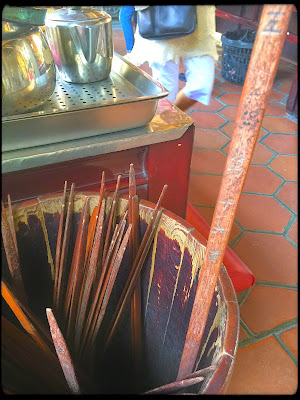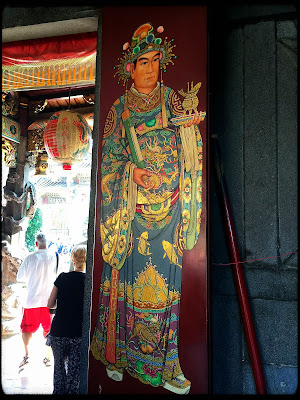From the East China Sea, we headed to the northern portion of Taiwan to Keelung. In order to reach Keelung and berth in it's harbor, we had to pass through the Taiwan Straits into the Keelung Traffic Separation Scheme, through the breakwaters and into the inner harbor.

The name "Taiwan" means "Rain City" - every year approximately 6-7 typhoons strike dumping wind, water and damage in their paths. For those who did not know, typhoons are the northwest Pacific Ocean version of what we call a hurricane in the Atlantic and northeast Pacific Ocean.

Once our tour bus left the Port of Keelung, we traveled 18 miles west to the one hundred year old bustling city of Taipei.
Founded by Hakka traders from the Chinese mainland during the 17th and 18th centuries, Taipei became Taiwan's capital city in 1885. Mandarin is the main spoken language of Taiwan. While under Japanese control from 1895 to 1945, Taipei experienced significant advances in modernization and developed into an influential political power. Then Communist rule from China seized control of Taiwan and the Taiwanese began a long and bloody struggle towards full democracy. The transition culminated in March 2000 in the election of Chen Shui-bian.

Along our journey to Taipei, I saw this unusual pink calculator which was an ad for a coffee shop.

Taipei was a picture of modern convenience and cleanliness.


Our first stop was the National Palace Museum in the Shilin district of Taipei. This was home to the world's largest and arguably finest collection of Asian art spanning over 8,000 years and ranging from paintings and calligraphy to textiles, metals and jade. There were four levels with three that offered exhibits and the fourth contained a teahouse that served tea, dim sung and vegetarian selections.






This magnificent partition (behind glass) showcased sections of jade in its various shades of green. Gorgeous!

After the museum, we went to the luxury Grand Hotel for a buffet lunch. The hotel opened in 1952 and was a beautiful symbol of Chinese architecture. It has hosted notable dignitaries such as visiting United States Presidents, Prime Minister Magaret Thatcher, Nelson Mandela and the King of Jordan.


Never in all my travels had I ever experienced such a welcome as when we arrived at the Grand Hotel. All of the hotel staff were lined up on both sides of the lobby entrance, from management to chefs and housekeeping staff. As we walked into the lobby, we were greeted by clapping and smiles, thanking us for our patronage. I was in awe both by the extravagant decor and such a warm greeting.


The intricate room dividers were incredible in detail and design.


The buffet was huge in selection and space. I tried many local cuisines such as Xiaolongbao, a type of small steamed dumpling and Lurou Fan, marinated pork boiled in soy sauce and served on rice.


Lunch at the Grand Hotel.

With full bellies and happy hearts, our tour then took us to the Marty's Shrine. This stately shrine was dedicated to the 330,000 brave men who sacrificed their lives during historic Chinese battles.

The guards at the gate were trained to remain absolutely composed. It was around mid-day and the weather was very humid and warm. Sweat ran down the faces of those men in their impossibly hot uniforms, but they remained absolutely still.


We arrived just in time to witness the military changing of the guard, which was quite reverent and impressive.



The grounds were immaculate and serene and surrounded in over 350,000 square feet of grass. The colors were vivid and there were various buildings on the vast grounds that contained beautiful murals and alters, all stunning in detail.










Next, we visited the Pao-an Temple, dedicated to the God of Medicine. It was very striking in its ornate architecture and dated back to 1830 when it was completed. In 2002, it was fully restored. Intricately carved dragons pillars, imposing stone lions and historic tablets inscribed by famous Chinese scholars were on display. The strong smell of burning incense permeated the air. There were multiple alters inside the temple. Each alter allowed worshippers to pay their respects to certain doctors and burn incense in their honor. The more popular the doctor, the "darker" the alter, created by the soot of burning incense. The "darker" alter was believed to shroud the face of the doctor.






When a worshipper had a question they wanted a Doctor to answer, they would pick a long bamboo stick at random from the provided receptacle (below - left). On the stick was a number. Then the worshipper grabbed two half moon shaped blocks (below - right) that were solid red on one side and plain wood on the other. They would say a prayer then drop the blocks three times. If the blocks fell same side up during those three times, the number on the stick was "no good" and they needed to choose a different stick and start over with the blocks until the correct number was found (meaning blocks did not fall on same side in any three drops).


Once a "good" number was secured, the worshipper went to the wall of pink prayer cards with numbers on them and chose the pink prayer card that corresponded with the "good" number. The answer to their prayer was the answer on that prayer card.

More examples of the workmanship in the decor that just took my breath away. Absolutely stunning.













Situated in the renowned Liberty Square of Taipei, the Chiang Kai-shek Memorial was an impressive monument honoring the former President of the Republic of China. The grounds were immense and contained multiple buildings including a theatre and museum.




The memorial to Chiang Kai-Shek was protected by a very stoic guard.


More structures and gardens gracing the Chiang Kai-shek Memorial






We passed construction of the Taipei Dome, future home for the 2017 Summer Universiade Olympics being held in Taipei. This dome has been under construction since 2011 and when completed will house a 40,000 seat indoor stadium.

The Xinyi District of Taipei housed "Taipei 101", the world's second tallest skyscraper. It wowed with its postmodern design featuring 101 floors built in eight sections, eight being a lucky number. Those 101 floors were aboveground with five below and a chic multilevel mall off to the one side of the building. Inside the middle of the building was a huge ball, or pendulum, that counter balanced for swaying due to winds and earthquakes. Floor 86 has two restaurants with amazing views of the skyline. The entire building is comprised of business tenants (no residents) totaling approximately 8,000 employees.

The Discovery Center, located in City Hall, was a museum that used visual and auditory data along with interactive exhibits to teach adults and children about the historical development of Taipei.







No comments:
Post a Comment